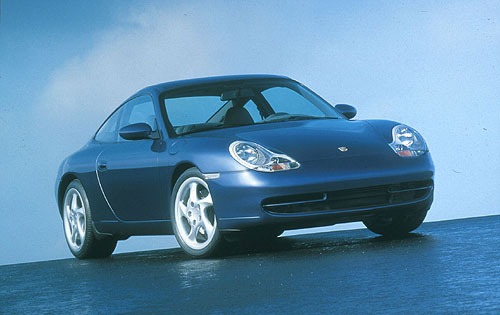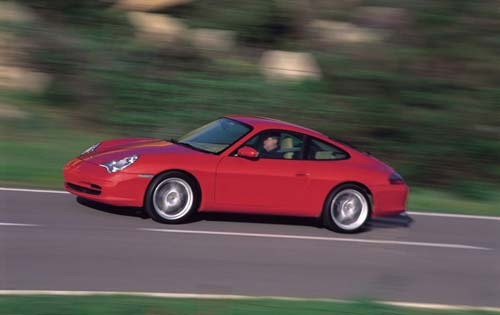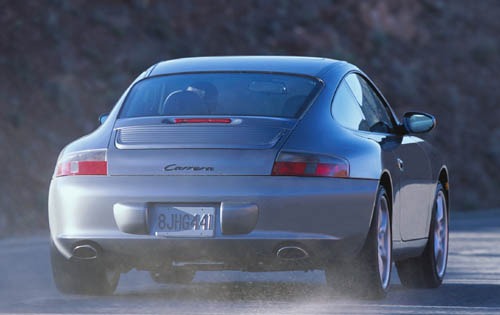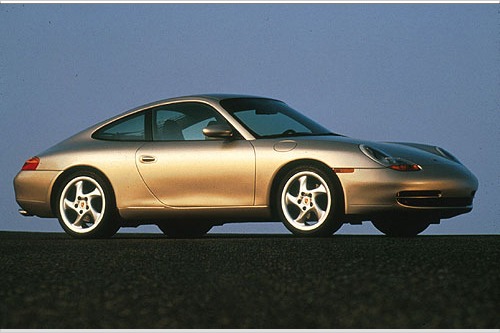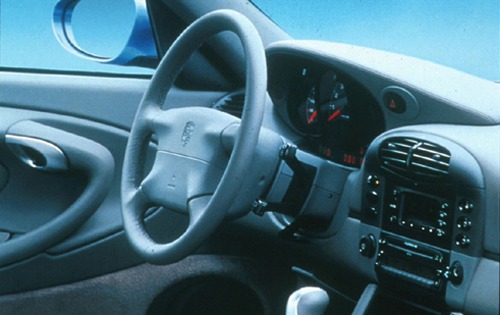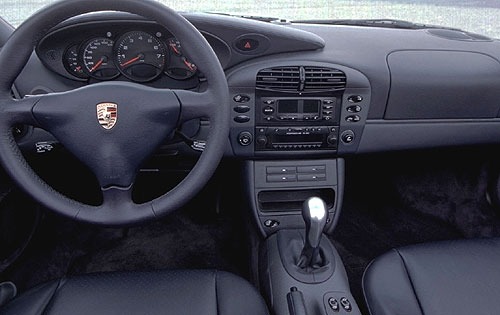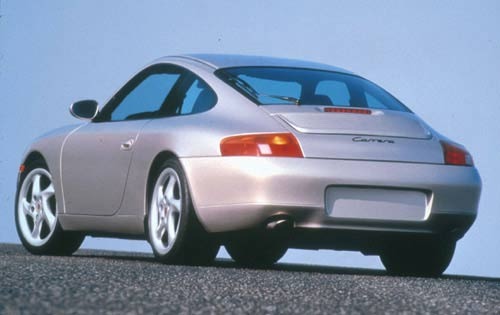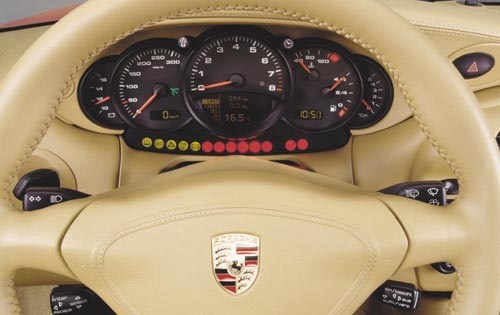The 996 generation (1999-2004) of the Porsche 911 may seem an odd choice for my normal selections of almost forgotten odd ball cars, but I need you to bear with me. Granted the Porsche 911 is one of the if not the most iconic sports cars of all time, the 996 has been regarded as the black sheep of the 911s.
The 996 was the first 911 to be liquid-cooled as opposed to the air-cooled flat-six engines that had been considered to be a defining characteristic of the 911. It also was the first and only generation since to have headlights that weren’t round. It also had an interior that contained a lot of fairly inexpensive feeling plastic materials that plagued most cars made during the same era. Finally, the M96 water-cooled engine has a very well documented issue with intermediate shaft bearing failure, which sends shards of hardened metal through the engines lubrication system basically destroying the engine.
When the 996 was introduced for the 1999 model year, Porsche purists from Stuttgart to Los Angeles were screaming bloody murder about the new 911s liquid-cooled engine. 911 fans loved the sound and simplicity of an air-cooled engine. When a rear engine vehicle is liquid-cooled like the 996, things get more complicated. Instead of a simple shroud over the engine with a belt driven fan pumping air around the cooling fins of the engine, the new engine required a radiator in the front of the car and a lot of plumbing to the rear where the engine is. Despite Porsche fans dismay, liquid-cooling was a pretty necessary step that Porsche had to make to get more power, and better emissions that the car would require to make it feasible to continue producing into the future. What the new liquid-cooled engine lost in character, it gained in performance and drivability.
Another aspect of the 996 despised by Porsche enthusiasts is the headlight design. Sometimes known as the “fried egg” headlight because of their odd shape and the amber turn signals in the early cars looked kind of like yellow yolks. Not only were they not round like a traditional 911, they looked exactly the same as the lesser model Porsche Boxster that was released 2 years previously. What the public did not understand was that the headlight was initially designed for the 996, however Porsche designers lifted the headlights from the at-the-time being developed 996 for the entry level Boxster, as they were trying to keep design and production costs down. This lead to the car world saying, “Hey, the new 911 looks like the cheap Porsche!” Needless to say, every generation of 911 since has donned relatively round headlights, and I don’t see that changing again for centuries.
All of the previous 911 to the 996 had relatively simple, but high quality interiors for their era. Air cooled 911 had simple, purposeful, and solid interiors made from high quality metals and leather. Minimal amounts of plastic and imitation materials were ever used in a 911. The 996 came along at a time when interiors had to have sculpted design attributes and expensive appearing materials. The problem was that Porsche wasn’t at it’s highest point financially at this time in history. Couple that along with the massive costs of developing a completely new liquid cooled flat-six, and the interior had to suffer. The 996 has been regarded by Porsche enthusiasts as one of the worst Porsche interiors ever. Low grade plastics finished to look like aluminum and leather, along with switches and levers that lack the tactile feel that is expected of a high-end German car left Porsche fans disappointed.
Finally, likely the most talked about issue with the 996 is the often catastrophic premature failure of the intermediate shaft bearing. Car forums and blogs around the world highlight this issue as the one and glaring reason not to ever buy a 996. It’s the ticking time bomb lurking behind the rear seats of every 996. When one of these bearings do fail, the cost is immense. If you tuned the engine off immediately after you have an inkling that the bearing has failed, you might get lucky and be able to salvage the engine block and heads that can be reused in the expensive rebuild. The likelihood of finding a used replacement engine is low as they are desirable since failures are fairly common, and if you do find one, it’s not going to come cheap.
So, with all of this doom and gloom, why am I endorsing this car? In short, it’s a 911. I can explain that statement a little bit better with a story. Back when I was in college, I was working for a large car dealership as a lot guy. One of the bonus tasks that I had was that I made a little extra money driving cars to a dealer auction that was about three hours away, and driving back a car that was purchased at the auction. The types of cars ranged from vehicles that didn’t fit on the car haulers, to sports cars that the boss didn’t trust with the car hauling company. I received a call from my boss one night just as I was leaving an evening class asking if I was available to drive a car to the auction. Me being a broke college student jumped at most any chance for extra money that I could. When he told me that it was a 2001 Porsche 911, needless to say I was quite excited. As I drove to the dealership to pick up the 911, I started to get a little bit down on my soon-to-come experience of driving a 996. Granted it was still the current generation 911 at the time, I had already known many of the gripes of the model. I was expecting the steering to be devoid of feel, and engine to be whisper quiet, and the car to generally lack character. I had driven a lot of cars at that job, and many I went in with high expectations, but left disappointed. I was anticipating this to happen with the 996. When I fired up the flat-six and left the car lot, it started occurring to me that it was not the case. Despite the lack of the noise from a fan to cool the engine, the 996’s flat six made a wonderful sound. When you brought the revs into the upper ranges, the sound is an almost spine-tingling scream that only a Porsche flat six can make. The steering to this day is the best steering I have ever experienced. You could feel every little pebble and crack in the road through the steering wheel, but at no point was it annoying. The car was surprisingly spacious and comfortable. You could easily drive the 996 across the continent in comfort, yet at the same time be in one of the best drivers cars ever made. It has a decent amount of luggage space, and according to the trip computer, I was able to get 25 miles per gallon, driving it spiritedly at times. This is what a 911 does. It strikes a no-compromise compromise between practicality and sport. 911s always have, and will likely continue to do so, if not better with every coming generation. I liken Porsche 911s to a really good microbrewery. Sometimes that awesome microbrewery comes out with a beer that isn’t as good as some of their others, but is still better than the best from other breweries.
So now that the driving dynamics have been addressed, how about the looks and interior quality. As far as looks go, you probably aren’t going to get past the non-round headlights, but as far as I’m concerned, who cares? Porsche snobs are going to turn the noses to 996s the same way they do to 944s. Whatever. The interior however is what it is. One way to make up for the low quality interior materials is to find one with the full leather option. At the time of original purchase, this was a really expensive option as it covered almost every reasonable part of the cars interior with color-matched leather. It took the inside of the cars from feeling like mid-90s VW Golf, to an Aston Martin. If you can’t deal with cheap interiors, this is your avenue to 996 ownership.
Now for the 400 pound gorilla in the room; the IMS bearing failure. Since this easily the biggest deterrent to 996 ownership, it has also made 996s among the least expensive used 911s to purchase. However, with the help from the aftermarket, there is a way to address the issue before a failure happens. Companies such as LN Engineering have developed much higher quality bearing replacements. When shopping around for a 996, you may want to only consider cars that have full service history documentation. Included in this documentation, there will likely be something in there showing the bearing was replaced for an upgraded part. If there isn’t, this can be used as a bargaining tool, as when the bearing is replaced, the clutch and rear main seal are accessible at the time and should be replaced at that time also. You are going to be facing a few thousand-dollar bill. But, like I said, you can potentially talk a seller down in price using the argument that you have a large repair ahead of you.
The whole reason I started this blog was to discuss affordable interesting cars that often get overlooked. The 996 compared to many other capable sports cars may still be more expensive, but when comparing to other Porsche 911s, they can be had for a bargain. This is the most reasonable method to get into a daily-drivable Porsche 911. If you educate yourself on the market and what to look for, you could be driving one of the best all-around practical drivers cars of all time, for less than a new Toyota Camry.
I stole photos for this post from:http://www.edmunds.com. If you are the owner of these photos and would like me to take them down, I will gladly do so. jj@doublejslist.com

